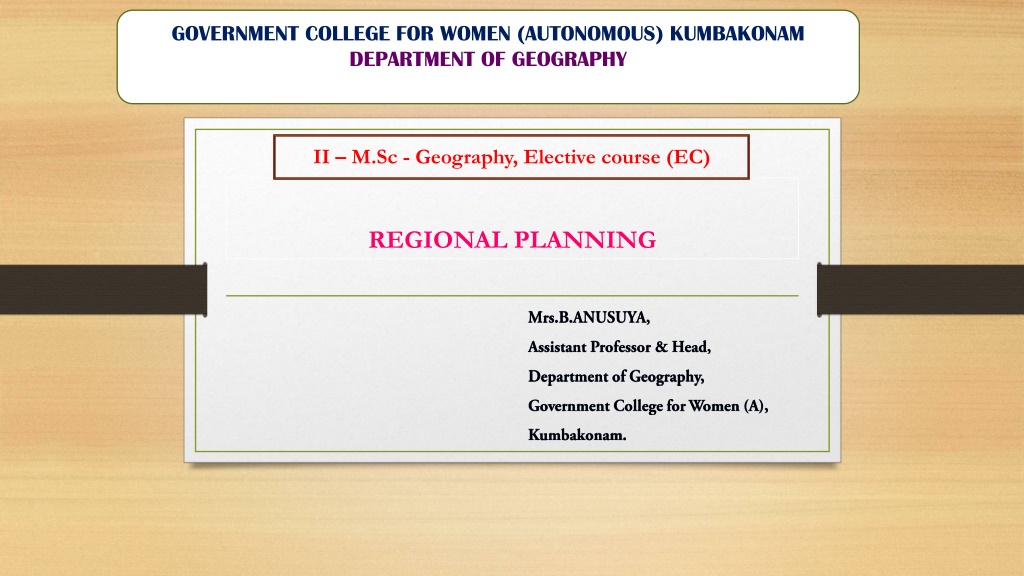Hill Area Development Programmes in India
Exploring the significance of Hill Area Development Programmes in India, focusing on the challenges faced by hill areas, the meaning of hills, the Tribal Area Development Programme, and the initiatives undertaken for sustainable development in these regions. The article discusses the fragile ecosystems, planning strategies for hill areas, and the unique characteristics of these terrains, highlighting the need for dedicated developmental efforts in such regions.
Uploaded on Sep 12, 2024 | 0 Views
Download Presentation

Please find below an Image/Link to download the presentation.
The content on the website is provided AS IS for your information and personal use only. It may not be sold, licensed, or shared on other websites without obtaining consent from the author.If you encounter any issues during the download, it is possible that the publisher has removed the file from their server.
You are allowed to download the files provided on this website for personal or commercial use, subject to the condition that they are used lawfully. All files are the property of their respective owners.
The content on the website is provided AS IS for your information and personal use only. It may not be sold, licensed, or shared on other websites without obtaining consent from the author.
E N D
Presentation Transcript
GOVERNMENT COLLEGE FOR WOMEN (AUTONOMOUS) KUMBAKONAM DEPARTMENT OF GEOGRAPHY II M.Sc - Geography, Elective course (EC) REGIONAL PLANNING
UNIT: III UNIT: III HILL AREA DEVELOPMENT PROGRAMME HILL AREA DEVELOPMENT PROGRAMME Introduction: The Hill area in India constitude roughly about 17% of the Total area of India. Nearly about 65 million people live in these areas. There are wide variation in resources and development potentials. Hill areas are found in the Himalayas, Western Ghats, Eastern Ghats and in some scattered hill areas. each and every state in India have hilly areas
What is the meaning of Hill? In other languages hill. British English: hill. A hill is an area of land that is higher than the land that surrounds it, but not as high as a mountain. I walked up the hill. A Natural Elevation of the Earth's surface, smaller than a mountain. an incline, especially in a road: This old jalopy won't make it up the next hill. an artificial heap, pile, or mound: a hill made by ants.
What does the name hills mean? A Natural elevation of the earth's surface, smaller than a mountain. an incline, especially in a road: This old jalopy won't make it up the next hill. an artificial heap, pile, or mound: a hill made by ants. a small mound of earth raised about a cultivated plant or a cluster of such plants. the plant or plants so surrounded: a hill of potatoes.
Hill Area Development Programme: The hill areas of the country support the basic life giving natural resources but they have very fragile and sensitive eco-systems. What is Hill area development programme? The Hill Area development Programme Cell was established at Udhagamandalam to formulate the Annual and Five Year plan proposals, scrutinize the proposals received, assess the viability of implementation of the schemes, frequent and effective inspections and review to ensure and timely completion of the works.
What is Tribal Area Development Programme? Tribal Area Development Programmes (TADP) Definition : The tribal situation in the country presents a varied picture. Some areas have high Tribal concentration while in other areas, the tribals form only a small portion of the total population. Planning for the Hill Areas of India:The hill areas are characterised by inaccessibility because of poorly developed infrastructure as it is expensive to lay roads and rail lines in the hilly terrain.
Because of inaccessibility, the areas are sparsely populated and the level of economic activity is low. Investment is also difficult to come by. Education, health and housing facilities in these regions reflect their underdeveloped nature. The fragile communication links that these regions have come under strain, often getting broken at times of heavy rains, snowfall, landslides, floods, etc.
Because of intrusion of outsiders with commercial intentions in these regions, deforestation and reckless construction activities are becoming increasingly common. This is threatening the fragile eco- system of hilly areas, causing widespread soil erosion and siltation of streams. These factors have a direct effect on productivity of land and on groundwater resources which are crucial for the survival of populations in these areas. Increasing disparity in levels of development in these areas and the rest of the country has given rise to a sense of alienation in some areas. The fact that the hilly regions of India are located along its borders, creates a sense of alienation in the people. This, in turn, often gets transformed into secessionist movements. Also, many of these areas are inhabited by tribals which makes the issue of development of hill areas even more significant.
The planning for hill regions was undertaken during the Fifth Plan under the target areas approach, and plans were prepared for eight districts of Uttar Pradesh hills, North Cachhar and Mikir hills in Assam, Darjeeling in West Bengal and Nilgiris in Tamil Nadu. The basic strategy revolved around financial and technical assistance and organisation of credit and marketing on cooperative basis. The development programme for hill areas, of Assam, for instance, is a comprehensive one covering areas such as land reclamation, checking soil erosion, scientific water management, afforestation, rehabilitation of shifting cultivators and minor irrigation. The programme also aims at employment generation through allied activities (horticulture, animal husbandry etc.), and improvement of basic infrastructure like roads and agricultural inputs.
Besides these, the programme includes a scheme for setting up coffee and rubber plantations and making the shifting cultivators owners of these plantations progressively. As the forerunner of a perspective planning exercise, techno-economic surveys have been initiated in some of these areas. But, adequate planning machinery equipped with skilled staff is not available.
Aim of The Study: To trace out the hilly areas in India and findout the problems related with these areas and suggest the measures to ensure the Socio-Economic development of hill areas as well as to know that what are the steps have been adopted by the Government to restore the improvement in such areas.
The adverse Natural Environmental is an abstracle in Socio-Economic development of Hilly areas. In India hill area have peculier problems. so, these areas are in need of such special programme, like Hill Area Development Programme and Triba Area Development Programme besides these the Government have been implemented many plans to improve the Quality of Tribal Areas people's life. Before Planning for their areas, the Environment of the hilly areas should be throughly understand. Generally the Hilly Areas have many barriers and problems.
The diverse Terrain, climate, economic status, culture, social condition as soon. But they entirely differ from place to place and which cause many problems. In the point of view, the Hill areas of India have been Classified as follows, 1) Hill Areas of NorthEastern States. 2) Hill Areas of Uttar Pradesh, West Bengal, Assam and TamilNadu... and 3) WersterGhats of Maharastra, Kerala and Karnataka.
Even Though the first 3 Five Year Plans, The Government have taken many steps to develop these areas the systematic integrated Hill Arae Development Programme was introduced during the 7th Five Year Plan. The Problems of Hill Areas are : 1. Deforestation, 2. Decline of Agricultural Productivity ( Slach and burn Age ) 3. Traditional agricultural Practices,
4. Soil erosion, 5. Mono Culture Forestry, 6. Over Grezing (due to livestock) 7. Construction of Roads, Dam, Industries and Mining activities are distrub the Forest Ecosystem. These Problems may be solved by : 1) By Improve the Horticulture. 2) Indroduce the New Techonologies/ Techiniques scienfific in Agricutural activity. 3) Tree Culture and Commercial Plantation.
4) Animal Husbandry Programme may be launched and scientific breeding of Cattle may ensure the Economic Development. 5) Electronic, watch making and optical glass may be started. 6) Cottage Indusriesmay be srtenthened.























